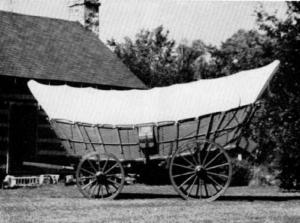 SKC Films Library |
| SKC Films Library >> Technology >> Wheelwright Industry |
| Conestoga a specific type of wagon developed and used in the Conestoga River Valley of Pennsylvania Prior to development of the Conestoga, settlers in the Conestoga Valley had to rely on pack horses to get supplies because the few roads into the region were too steep and deeply rutted to allow travel by flatbed wagons with narrow wheels. The most distinctive part of the Conestoga's design was its belly, which sloped up at each end to prevent cargo from shifting while the wagon was negotiating a steep incline or decline. It also featured a canvas top (almost always white) pulled taut over wooden hoops to keep the cargo safe from inclement weather, and rear wheels up to a foot wide and six feet across that could traverse even the muddiest roads without leaving deep ruts behind. Most Conestogas were 14-16 feet long, but 20 feet or more was not uncommon. Typically pulled by a team of four to six horses, the largest Conestogas could easily hold six tons of cargo. Another characteristic feature of the Conestoga is the absence of a driver's seat. Instead of riding, the driver usually controlled his horse team either by while walking alongside the wagon or while mounted on a rear horse. And, since the lead horse was almost always on the left side, the driver walked or rode on the left; this is likely where the American custom of driving on the right side of the road originated. The driver could also choose to control his team while standing or sitting on a board that slid out from beneath the wagon bed in front of either rear wheel; since that board was known as the "lazy board," drivers who used it were commonly referred to as "lazy." Use of the Conestoga peaked between 1820 and 1840, when pioneers first began crossing the Allegheny Mountains into what was then the western frontier. Contrary to some commonly cited sources, Conestogas were not a principal means of transport for those migrating into the Great Plains and beyond because the same qualities that made the Conestoga an ideal carrier of cargo in the region in which they were developed made it way too heavy to be pulled long distances. While similar looking covered wagons can be seen in pictures of wagon trains heading west, those wagons were actually known as "prairie schooners" and bore little resemblance to Conestogas aside from the canvas tops. |
| SKC Films Library >> Technology >> Wheelwright Industry This page was last updated on November 12, 2017. |
